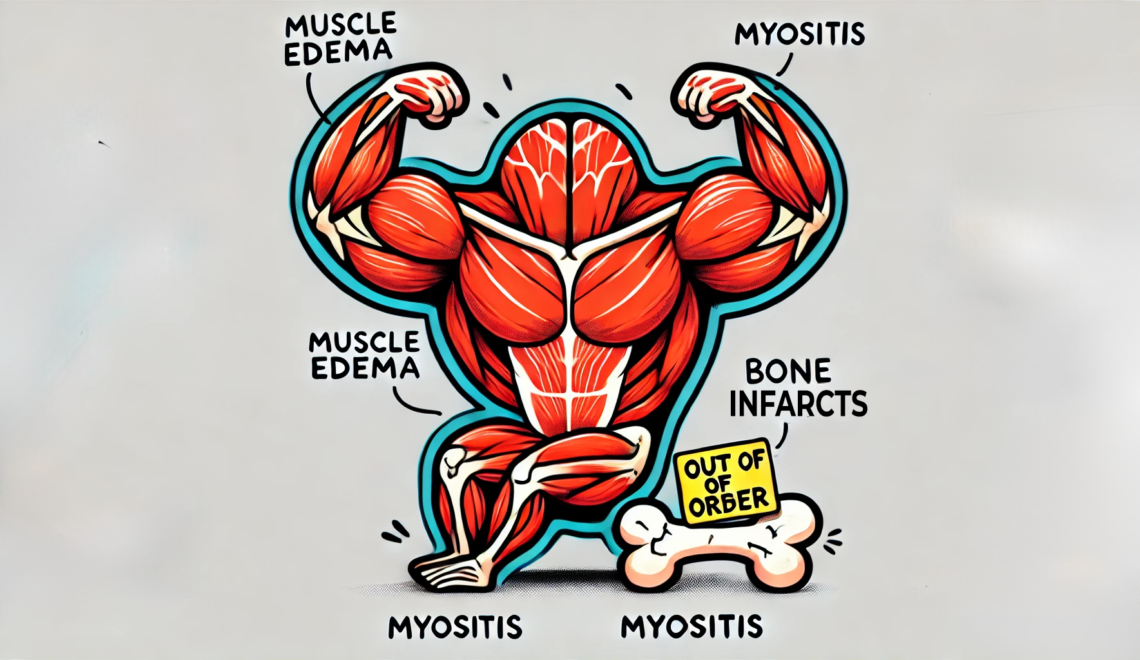MRI Results Decoded: The Wild Ride of Muscle Edema, Myositis, and Bone Infarcts

Alright, folks, grab your popcorn because today, we’re diving into the thrilling world of MRI results. If you’re like me, you probably stared blankly at your doctor when they started throwing around terms like “muscle edema” and “bone infarcts.” And then there’s the pièce de résistance: the biopsy. So, let’s break it down into normal-person language and figure out what in the world is going on inside these thighs of mine!
MRI Results: What’s Happening in My Thighs?
So, I had an MRI done on my legs, and here’s what the report said: patchy muscle edema in both thighs, most evident at the level of the posterior muscular compartment. Sounds fancy, right? Let’s translate that.
- Patchy Muscle Edema: This is just a fancy way of saying that there are spots of swelling in the muscles of my thighs. Think of it like a sponge soaking up water—my muscles are a bit too hydrated in places, but not in a good way. The swelling can make the muscles feel weak, sore, or just plain tired.
- Posterior Muscular Compartment: This is a highfalutin term for the back part of my thigh muscles. So, picture the back of your thighs after leg day at the gym—tight, sore, and maybe a little confused about why you decided to exercise in the first place. That’s where most of the action is happening.
- Bone Infarcts in the Proximal and Distal Femurs: Now, this one sounds serious, but don’t panic just yet. A bone infarct is like a tiny bone bruise deep inside the bone. It’s what happens when blood flow is disrupted, leading to a small area of dead bone. Imagine your bone saying, “You know what? I’m taking a nap right here.” The proximal femur is the upper part of your thigh bone, close to your hip, and the distal femur is the lower part, near your knee. So, I’ve got these napping bone spots at both ends of my thigh bone. Lovely.
Inflammatory Myopathy/Myositis: The Muscle Drama
The MRI results also mentioned something called inflammatory myopathy/myositis. Now, that’s a mouthful! In simpler terms, myopathy means there’s something wrong with the muscles, and myositis is inflammation or swelling of the muscles. So, we’re basically talking about muscle drama. My muscles have decided to throw a little tantrum, and now they’re all puffy and sore. Why? Great question! It could be due to an autoimmune response (where the body decides it wants to fight itself) or another underlying issue, which is why we’re doing further tests.
What’s the Deal with the Biopsy?
And speaking of further tests, let’s talk about the biopsy. You know, that fun little procedure where they take a tiny piece of your muscle or bone to look at it under a microscope. But why are they doing this? Simple: they want to get up close and personal with my muscle and bone cells to figure out exactly what’s causing all this drama.
- Looking for Inflammation: The biopsy will show if there’s inflammation in the muscles. If there is, it might confirm that my muscles are indeed throwing a party without my permission, a.k.a. myositis.
- Checking for Infections or Other Issues: They’ll also check for any infections or other sneaky conditions that could be causing the symptoms. It’s like when you have a house party, and you need to check if someone’s hiding in the bathroom—you need to know what you’re dealing with!
Complex Terms Decoded:
- Edema: Swelling caused by excess fluid trapped in the body’s tissues. Think of it like a water balloon that’s overfilled.
- Myopathy: A general term for muscle disease or dysfunction. It’s like saying your muscles aren’t quite living up to their potential.
- Myositis: Inflammation of the muscles, which can cause pain, weakness, or swelling. Basically, your muscles are mad about something.
- Bone Infarct: A small area of dead bone tissue due to lack of blood supply. Think of it as a mini bone power outage.
Why All This Matters:
So why does any of this matter? Well, figuring out what’s going on in my thighs is crucial for getting the right treatment. Whether it’s medication to calm down the muscle inflammation or other therapies to improve blood flow to my bones, knowing exactly what’s happening means we can tackle it head-on.
Conclusion:
So there you have it—my MRI adventure decoded for normal people. It’s a wild ride of muscle edema, bone naps, and a biopsy that’s basically a muscle inspection. But now that we know what we’re dealing with, we can get to work fixing it. And hey, if nothing else, at least I’m learning a lot of fancy medical terms to impress my friends with!



